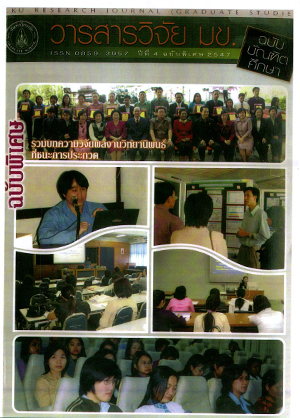ผลขอการปรับสมดุลความเหมาะสมของแหล่งพลังงานและโปรตีนในการเพาะรูเมนต่อปริมาณการกินได้, กระบวนการหมักของจุลินทรีย์, การใช้ประโยชน์ได้ของโภชนะและสมรรถนะของโครีดนม (Effect of synchronizing starch sources and protein (NPN) in the rumen on feed intake, ruman mic
Keywords:
synchronizing, cassava chip, com, ruminal microbial fermentation, dairy cowsAbstract
การศึกษาผลของแหล่งคาร์โบไฮเดรต 2 ชนิด (ข้าวโพด และมันเส้น) ที่มีความสามรถในการย่อยสลายได้ต่างกันและมีการใช้สูตรอาหาร 2 ระดับ (55 และ 75 เปอณ์เซ็นต์) ร่วมกับแหล่งสารประกอบไนโตรเจนที่ไม่ใช่โปรตีนแท้ (ยูเรีย) ที่มีผลต่อปริมาณการกินได้ ความสารถในการย่อยได้ นิเวศวิทยา ในกระเพาะรูเมน การใช้ประโยชน์ทางโภชนะ และผลผลิต และองค์ประกอบน้ำนมในโคนม โดยสุ่มโคให้ได้รับอาหารทดลอง 4 สูตร ดังนี้ กลุ่มที่ 1 ข้าวโพดระดับ 55 เปอร์เซ็นต์ กลุ่มทดลองที่ 2 ข้าวโพดระดับ 75 เปอร์เซ็นต์ กลุ่มทดลองที่ 3 มันเส้น 55 เปอร์เซ็นต์ และกลุ่มทดลองที่ 4 มันเส้น 75 เปอร์เซ็นต์ตามแผนการทดลองแบบสลับ (Switch back design) โดยจัดทรีทเมนต์แบบ 2x2 แฟคตอเรียล (factorial arrangement) ใช้โคนมพันธ์ผสมโฮลสไตน์-ฟรีเซี่ยน จำนวน 8 ตัว น้ำหนักเฉลี่ย 383 +- 10 กิโลกรัม และมีจำนวนวันของการให้นมเฉลี่ย 153 +- 6 วัน โดยโคนมทุกตัวรับฟางหมักปุ๋ยยูเรีย 5 เปอร์เซ็นเป็นอาหารหยาบให้กินแบบเต็มที่ และเสริมมันเฮย์ 1 กิโลกรัม(น้ำหนักแห้ง) ต่อตัวต่อวัน การทดลองแบ่งออกเป็น 3 ช่วงการทดลอง แต่ละช่วงใช้เวลา 21 วัน โดย 14 วันแรกเป็นการปรับตัวสัตว์และ 7 วันหลังเป็นระยะเก็บตัวอย่าง จากผลการทดลองพบว่า ปริมาณการกินได้ทั้งหมด น้ำหนักตัว และสัมประสิทธิ์การย่อยได้ของวัตถุแห้งไม่แตกต่างกันทางสถิติ (P>0.05) ค่าความเข้มข้นของแอมโมเนีย-ไนโตรเจน, ยูเรีย-ไนโตรเจนในกระแสเลือด และยูเรีย-ไนโตรเจนในน้ำนม ไม่มีความแตกต่างกันทางสถิติ P>0.05) แต่เพิ่มตามระดับของแหล่งคาร์โบไฮเดรตที่เพิ่มขึ้น ความเข้าข้นของแอมโมเนีย-ไนโตรเจนเท่ากับ 15.6, 20.0, 16.6, และ 18.1 mg/dl ในกลุ่มทดลองที่ 1,2,3และ 4 ตามลำดับ จำนวนประชากรจุลินทรีย์และแบคทีเรียทั้งหมดมีค่าไม่แตกต่างกันทางสถิติ (P>0.05) แต่พบว่า ซูโอสเปอร์ (Zoospores) ของเชื้อราในกลุ่มที่ได้รับมันเส้นมีแนวโน้มสูงกว่ากลุ่มที่ได้รับข้าวโพดเป็นหลัก ผลผลิตนม ประสิทธิภาพการผลิตนม และองค์ประกอบทางเคมีของน้ำนมไม่มีความแตกต่างกันทางสถิติ (P>0.05) ในทุกกลุ่ม อย่างไรก็ตามเปอร์เซ็นต์ไขมันเฉลี่ยของน้ำนมในกลุ่มที่ได้รับมันเส้นดีกว่ากลุ่มที่ได้รับข้าวโพด (4.4 และ 4.2 เปอร์เซ็นต์ ตามลำดับ) ผลตอบแทนเปรียบเทียบเชิงเศรษฐกิจโดยเฉลี่ยเมื่อปรับไขมันที่ 3.5 เปอร์เซ็นต์ พบว่าในกลุ่มที่ได้รับมันเส้นสูงกว่ากลุ่มที่ได้รับข้าวโพด (54.0 และ 51.4 Us$/Month ตามลำดับ) ดังนั้นการให้อาหารที่มีมันเส้นเป็นแหล่งพลังงานหลัก และ/หรือ ในระดังสูงมากกว่า 55 เปอร์เซ็นต์ (55-75 เปอร์เซ็นต์ ของวัตถุแห้ง) ร่วมกับสารประกอบไนโตรเจนที่ไม่ใช่โปรตีนแท้ (ยูเรีย) มากกว่า 3 เปอร์เซ็นต์ (3-4.5 เปอร์เซ็นต์) สามารถใช้ได้ในสูตรอาหารโคนมโดยไม่ทำให้นิเวศวิทยาในการเพาะรูเมนเปลี่ยนแปลง หรือสมรรถภาพของสัตว์ด้วยลงเมื่อเปรียบเทียบกับสูตรอาหารที่มีข้าวโพดเป็นหลัก
Eight multiparous Holstein-Friesian crossbred cows in mid-lactation were randomly assigned to a switchback design with a 2x2 factorial arrangement of treatments to evaluate two non-structural carbohydrate sources (cassava and com) with different rumen degradability and used at two levels (L) of nonstructural carbohydrate (NSC) (55 vs. 75°/o) with crude protein source (supplied by urea in the concentrate mix) were conducted to investigate feed intake, rumen microbial fermentation, nutrient utilization and performance. The dietary treatments were 1) Low degradable, low level of com (5596) (Tl), 2) Low degradable, high level of com (7596) (T2), 3) High degradable, low level of cassava (5596) (T3) and 4) High degradable, high level of cassava (7596) (T4). The cows were offered the treatment concentrate at a ratio to milk yield at 1:2. Urea-treated rice straw was offered ad libitum as the roughage and supplement with 1 kg/hd/d cassava hay. The results revealed that total DM intake, BW and digestion coefficients of DM were not affected by either level or source of energy. Rumen fermentation parameters; NH^-N, blood urea nitrogen and milk urea nitrogen were unaffected by source of energy, but were dramatically increased by level of NSC. Ruminal NH^-N concentration averaged 15.6, 20.0, 16.6 and 18.1 mg/dl for diet Tl, T2, T3 and T4, respectively. Likewise, blood-urea nitrogen was increased by level of NSC. Total direct counts, total viable bacterial counts, proteolytic, cellulolytic and amylolytic bacteria were not affected (p>0.05) by source of energy, but fungal zoospores were greater for cassava-based concentrate than corn-based concentrate. Milk production, efficiency of milk production, and milk composition were not affected significantly by diets containing either source or level of NSC, however milk fat percentage showed a trend towards higher levels for cassava-based concentrate than com-based concentrate averaging (4.4 and 4.2, respectively). Likewise, income over feed, as estimated from 3.596 FCM, was higher on cassava-based concentrate than corn-based concentrate averaging (54.0 and 51,4 us$ /mo, respectively). These results indicate that feeding diets containing either cassava-based diets and/ or a higher of concentrates up to 7596 of DM with NPN (supplied by urea up to 4.5'#’ of DM) can be used in dairy rations without altering rumen ecology or animal performance compared with corn-based concentrate.



